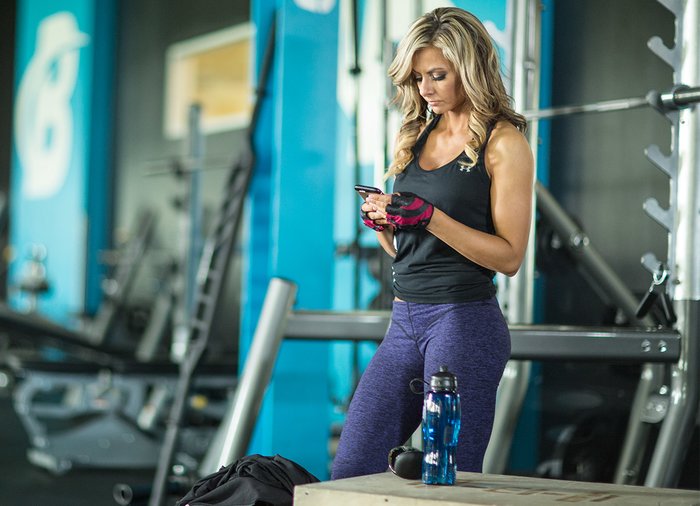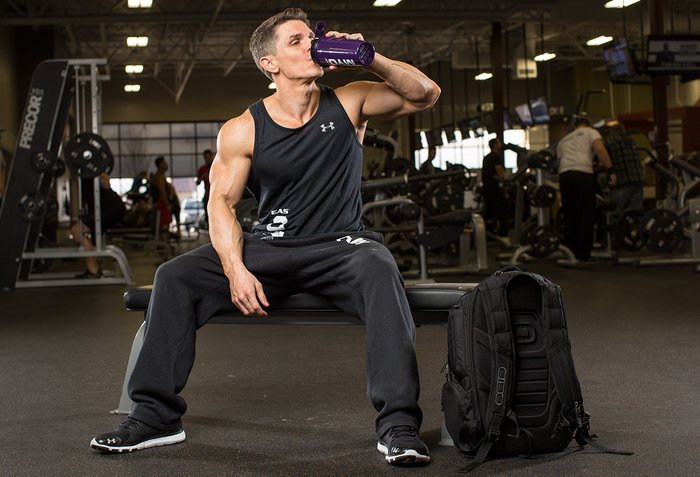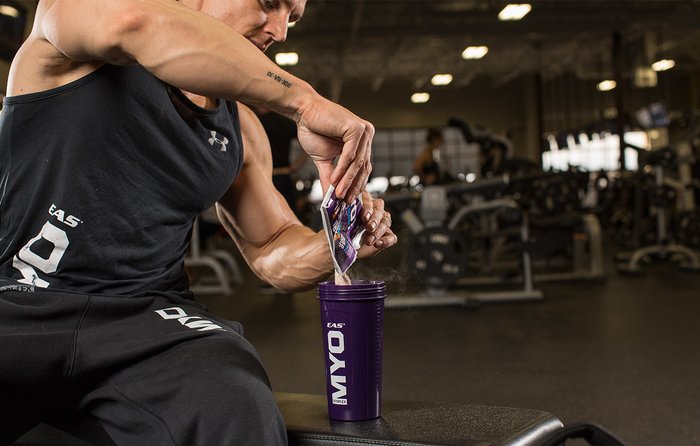Most people who venture into the gym feel motivated to succeed. While Bodybuilding.com can help, a big knowledge gap often separates those who succeed from those who don't. Sometimes, individuals are so short on know-how that they fail before they even step foot in the gym. That doesn't have to happen to you.
With the help of two EAS athletes—fitness model Jason Wittrock and NPC bikini competitor Nikki Walter—we can guarantee an end to unproductive workouts by addressing seven common pre-workout mistakes to avoid.
1. Going in Without a Plan
Nothing worth achieving is accomplished haphazardly. That goes for fitness too. You can't reach a goal if you have no road map of how you'll get there. "Setting concrete goals is important," Walter explains. "By knowing what you need to improve upon and build, you now have something to measure your progress against."

A good plan should also be flexible enough to meet changing conditions. "Along the way, you should review your program and adjust as necessary, making sure it's a good fit for your lifestyle," says Walter. For instance, if you find you're always missing your Saturday workouts, try shifting that session to another day and making Saturday a rest day. Or if you dread a certain exercise, don't force yourself to do it. Trade it out for a similar movement that's more palatable.
"Reviewing your plan also helps you stay focused and motivated," Walter adds. "When I feel like I'm overwhelmed by things that come up, I've learned to compromise and work it out to fit my lifestyle. That means balancing work with being a mom and all of the other things I enjoy doing. That way, I can do it all!"
2. Eating Too Much Junk in the 24 Hours Before Your Workout
Elite athletes know that it's not just what you eat right before your workout that'll make the biggest difference in your gym performance. It's what your nutrition has been in the 24 hours prior.
So, your preparation for tomorrow's training session begins today, with smart food choices and timing. Eat every 3-4 hours, getting quality protein from sources like lean beef, fish, poultry, and eggs, and quality carbohydrates from green vegetables and complex sources like brown rice and whole grains.
A typical fitness-minded diet could break down as follows: 40 percent of your daily diet made up of high-quality protein, 40 percent carbohydrates, and 20 percent fat, focusing on healthy monounsaturated fats, polyunsaturated fats, and omega-3 fatty acids. (Quality fat sources include olive oil, nuts and seeds, avocadoes, flaxseeds, and fish like mackerel or salmon.)
3. Skipping Your Pre-workout Shake
A well-designed resistance-training program tears down muscle fibers, but you could jump-start the recovery process even before you complete your first rep. About 30-45 minutes before your start, drink a whey protein shake. Sure, you could get that protein through whole foods, but whey digests faster and won't weigh you down like whole foods can once you hit the gym.

You may also want to consider a supplement specifically designed for a pre-workout boost, like EAS Myoplex Pre-Workout, which includes beta-alanine, caffeine for energy and performance, and beetroot extract and the Peak ATP formula to improve nitric-oxide levels. Beetroot extract, which is an excellent source of nitrates, is a great way to boost the production of NO. It has been suggested in numerous studies to enhance performance, delay fatigue, and increase exercise tolerance.[1]
"To help prevent post-workout muscle breakdown, I aim for 20-50 grams of protein before a hard cardio regimen and 30 grams before weight training," Walter says. "I find that on longer workouts, it's best for me to sip protein throughout if I need to curb hunger, instead of waiting to drink a shake afterward. It ensures I'm getting in my aminos."
4. Forgetting the Rehearsal
Most of us have ambled into the gym on occasion not mentally prepared. We may not have even given the upcoming training a second thought before we arrived, because we've been way too busy with work, family, errands ... you know, life. That said, we also know that the body isn't simply a physical organism: For optimal workout effectiveness, the brain must be engaged, too.
Before lifting your first dumbbell of the day, mentally prep yourself. A good time to do this is during your pre-workout meal. Envision what the perfect workout looks like—the exercises you'll do, the form you'll use, the poundages you'll handle, and so on.
Continue that mindset in the weight room. "Before every exercise, I mentally prepare by visualizing myself executing with perfect form, tempo, and purpose," Wittrock says. "This is especially important for a heavy set that requires maximum intensity. For example, if I'm about to do a heavy set of bench presses, and my goal is to perform 5 reps, I'll first visualize myself successfully performing all 5 reps with perfect form and ease. This creates an almost subconscious effect of self-confidence. My brain has already succeeded and knows what to expect. Now it's up to my body to follow."
5. Maximizing Your Cardio
If fat loss is your goal, cardio may seem paramount. Plenty of people think that way, and they'll put themselves through long daily aerobic sessions in an effort to burn extra calories. Unfortunately, steady-state cardio, in which you maintain the same pace throughout the workout, isn't the most efficient way to burn calories, primarily because you're only doing so during the activity and for a brief time afterward.

In contrast, high-intensity interval training (HIIT) gooses your metabolism for as long as 24 hours post-workout. It does so by driving up what's known as excess post-exercise oxygen consumptions, or EPOC. Resistance training has much the same effect on your body, and both are better options for burning calories than steady-state cardio.
You may even want to split your resistance training and HIIT cardio workouts, doing one in the morning and the other in the evening, to better ensure one doesn't detract from the other.
6. Not Taking Warm-ups Seriously
A few halfhearted light sets of your first exercise aren't enough to shift your body into gear physically and mentally for the exertion to come.
The best place to start is with some light cardio activity to get the blood pumping and increase your circulation, warming up muscle tissues and joints. Go as long as it takes to break a sweat, usually 5-10 minutes. Then, you can start with the first movement in your exercise routine.
Even here, paying attention to your warm-up sets pays dividends. "I take my warm-up sets just as seriously as my last set," Wittrock says. "I'm rehearsing the movement pattern, warming up the working musculature, and engaging my mind and preparing it for the battle ahead." During his warm-up sets, Wittrock takes himself through a mental checklist:
- First, he focuses on the target muscle and works to "silence" the surrounding muscles. For example, when doing biceps curls, Wittrock makes sure he's using his biceps, and consciously reminds himself to keep his shoulders out of the movement.
- Second, Wittrock focuses on full range of motion. He makes sure he's fully stretching the muscle and squeezing it at the top of every rep.
- Third, he makes sure his tempo is what he wants. Wittrock focuses on controlling both the positive and negative portions of each rep.
- Fourth, Wittrock focuses on his breathing, making sure he's inhaling and exhaling at the proper times.
7. Not Planning For Intra-Workout And Post-Workout Fueling
The middle of your workout is no place to find yourself with hunger cravings or falling energy levels. Even worse is finding yourself tied up in a commitment immediately post-workout where you won't have access healthy food. That means packing foods and shakes ahead of time to take care of your intra-workout and post-workout nutrition needs.

At the very least, make sure you're drinking plenty of water. If your training is particularly intense and/or you're sweating extensively, replace electrolytes with a low-calorie sports drink containing 125-180 milligrams of sodium and 23-50 milligrams of potassium per 8 ounces. Otherwise, add electrolyte tablets to your water.
After your training session, you might feel especially drained, so having something readily available will help jump-start the recovery process. A post-workout shake works extremely well here, especially one that includes casein and whey (15-20 grams each), and 60-80 grams of a quick-acting carb like pure dextrose powder or fruit juice. The protein aids the body's repair processes, while the simple carbs prompt an insulin response that helps open up pathways to store glycogen for energy and push amino acids into muscle cells. You may also want to add 5 grams each of glutamine and BCAAs to aid muscle repair.
References
- Bailey, S. J., Fulford, J., Vanhatalo, A., Winyard, P. G., Blackwell, J. R., DiMenna, F. J., ... & Jones, A. M. (2010). Dietary nitrate supplementation enhances muscle contractile efficiency during knee-extensor exercise in humans. Journal of Applied Physiology, 109(1), 135-148.

